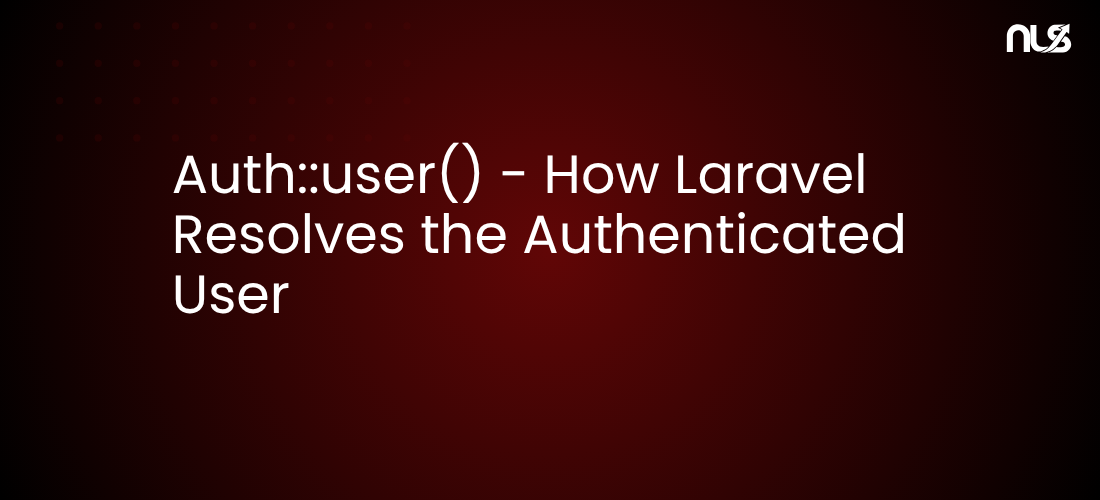Ever wondered what happens when you call Auth::user() in your Laravel application? It seems like magic—you call a simple method and instantly get the authenticated user's data. But there's fascinating engineering behind this seemingly simple facade.
What Actually Happens Behind Auth::user()?
When you call Auth::user(), Laravel goes through a multi-step process to retrieve and return the currently authenticated user. It's not pulling data from thin air—it's intelligently checking sessions, tokens, and guards to identify who's making the request.
Let's break down exactly what happens in those microseconds.
The Authentication Flow Step-by-Step
1. Facade Resolution
When you write Auth::user(), you're actually calling a facade. Laravel resolves this to the AuthManager class, which acts as a factory for authentication guards.
// What you write
$user = Auth::user();
// What Laravel actually calls
$user = app('auth')->user();
The Auth facade is just a convenient wrapper around Laravel's authentication manager.
2. Guard Selection
Laravel needs to know which guard to use. By default, it uses the web guard for browser sessions and api guard for API requests. The guard is defined in config/auth.php:
'defaults' => [
'guard' => 'web',
'passwords' => 'users',
],
Laravel automatically selects the appropriate guard based on your authentication middleware configuration.
3. Session Verification (for Web Guard)
For the default web guard, Laravel checks the session storage:
// Behind the scenes
$userId = session()->get('login_web_' . sha1(static::class));
Laravel stores the authenticated user's ID in the session with a hashed key for security. If the session exists and is valid, it proceeds to the next step.
4. User Retrieval from Database
Once Laravel has the user ID from the session, it queries the database:
// Simplified version of what happens
$user = User::find($userId);
But Laravel is smart—it only queries the database once per request. After the first call to Auth::user(), the result is cached in memory.
5. User Instance Caching
This is crucial for performance:
// First call - queries database
$user = Auth::user(); // SELECT * FROM users WHERE id = ?
// Second call - uses cached instance
$user = Auth::user(); // No query!
Laravel stores the user instance in the guard object, so subsequent calls in the same request are instant.
Practical Example: The Complete Flow
Here's what happens in a typical controller action:
use Illuminate\Support\Facades\Auth;
class DashboardController extends Controller
{
public function index()
{
// Laravel checks session, finds user ID, queries DB
$user = Auth::user();
// This call uses the cached instance - no DB query
$userName = Auth::user()->name;
// You can also check authentication status
if (Auth::check()) {
// User is authenticated
return view('dashboard', ['user' => $user]);
}
return redirect()->route('login');
}
}
How Different Guards Work
Laravel supports multiple authentication guards for different scenarios:
Session Guard (Default for Web)
// Uses Laravel sessions and cookies
Auth::guard('web')->user();
Stores user ID in session, queries on each request (but caches in memory).
Token Guard (Sanctum)
// Uses bearer tokens
Auth::guard('sanctum')->user();
Verifies the Authorization: Bearer {token} header, queries the personal_access_tokens table, and returns the associated user.
The NULL Safety Check
Important gotcha: Auth::user() can return null if no user is authenticated:
// Unsafe - can cause errors
$name = Auth::user()->name;
// Safe - checks authentication first
$name = Auth::user()?->name ?? 'Guest';
// Better - use Auth::check()
if (Auth::check()) {
$name = Auth::user()->name;
}
Performance Consideration
Since Laravel caches the user instance, calling Auth::user() multiple times has minimal performance impact:
// All these calls use the same cached instance
$user = Auth::user();
$email = Auth::user()->email;
$role = Auth::user()->role;
// Only ONE database query is executed
When Auth::user() Returns NULL
The method returns null in these scenarios:
- No authentication middleware applied to the route
- User session expired or was invalidated
- Invalid authentication token (for API guards)
- User account deleted but session still exists
- Guest user accessing public routes
Pro Tip: Alternative Access Methods
You can access the authenticated user in several ways:
// Using the Auth facade
$user = Auth::user();
// Using the request helper
$user = request()->user();
// Using dependency injection
public function show(Request $request)
{
$user = $request->user();
}
// Using the auth() helper
$user = auth()->user();
All these methods ultimately call the same underlying authentication system.
Common Mistakes to Avoid
Mistake 1: Assuming user is always authenticated
// Wrong - can cause null reference error
$name = Auth::user()->name;
// Right - check authentication first
$name = Auth::check() ? Auth::user()->name : 'Guest';
Mistake 2: Unnecessarily storing in variables
// Inefficient - creates unnecessary variable
$user = Auth::user();
$userId = $user->id;
// Better - direct access (same performance)
$userId = Auth::user()->id;
Conclusion
Understanding how Auth::user() works gives you insight into Laravel's elegant authentication system. It's a carefully orchestrated process involving facades, guards, sessions, and intelligent caching—all happening in milliseconds to securely identify your users.
Next time you use Auth::user(), you'll know it's not magic—it's beautiful engineering.
Need help migrating or upgrading your Laravel authentication system? At NeedLaravelSite, we specialize in Laravel application migrations and upgrades from version 7 to 12, ensuring your authentication flows work flawlessly.


